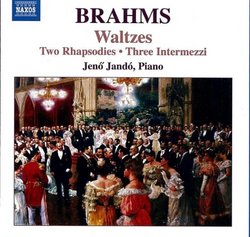| All Artists: Johannes Brahms, Jenö Jandó Title: Brahms: Waltzes; Variations and Fugue on a Theme of Handel Members Wishing: 0 Total Copies: 0 Label: Naxos Original Release Date: 1/1/2007 Re-Release Date: 5/29/2007 Genre: Classical Styles: Chamber Music, Historical Periods, Classical (c.1770-1830) Number of Discs: 1 SwapaCD Credits: 1 UPC: 747313029075 |
Search - Johannes Brahms, Jenö Jandó :: Brahms: Waltzes; Variations and Fugue on a Theme of Handel
 | Johannes Brahms, Jenö Jandó Brahms: Waltzes; Variations and Fugue on a Theme of Handel Genre: Classical |
Larger Image |
CD Details |
CD ReviewsBrahms's Marvelous Waltzes and 'Handel Variations' J Scott Morrison | Middlebury VT, USA | 07/04/2007 (5 out of 5 stars) "Brahms is so often thought of as a somewhat dour classicist whose primary interest compositionally was to compose beautifully mitered works that harked in their construction back to the abstract models of the classic period or earlier. But, truth to tell, he was just as interested in dance forms and he was a master of them. Consider, for example, such works as the Liebeslieder Waltzes or the Hungarian Dances. The present set of sexteen waltzes, the Opus 39, were written in 1864, in both two-hand and four-hand versions. They were published shortly after and became best-sellers. Ah, the glory days of music-making in the home!
Often Brahms's piano music is played with a somewhat heavy hand, at least partly because it is often bass-dominated. That is definitely not the case with these performances by Jenó Jandó, surely the busiest pianist in Naxos's stable of fine musicians. He plays with a deft and sure but delicate touch, and the waltzes benefit. These may not be quite at the level of Julius Katchen's recording, generally considered classic Brahms playing, but they come close. Also included at the two Op. 79 Rhapsodies and the three Intermezzi, Op. 117. There are many fine recordings of these miniatures, but Jandó does a creditable job with them. The biggest and most important work here is perhaps the apex of Brahms's solo piano output -- the Variations and Fugue on a Theme of Handel, Op. 24. The theme is from Handel's Harpsichord Suite in B flat, HWV 434 (1733). Handel himself had subjected the theme to five variations. Brahms, on the other hand, wrote twenty-five variations and concluded with a huge fugue based on the theme. The work is as virtuosic as anything Brahms ever wrote. In the first variation Brahms brings us immediately into his own age with its saucy stride-like bass and the dizzying figurations in the right hand. Variation 2 is an exercise in two against three. No. 3 is perky and there is no stronger contrast than with No. 4 which has heavy octaves. No. 5 moves into the tonic minor key and is cleverly contrapuntal. No. 6, also in the minor, is a canon at the octave. No. 7 sounds like cantering horses and moves without pause into No. 8 which continues the rhythmic excitement. No. 9 is a portentous legato announcement ushering in section II of the work. No. 10 harks back to the cantering horses and is followed by a music-box, No. 11. The writing gets more complicated with No. 12; the variations are intertwined and seem almost variations upon variations. A tinge of Hungarian gypsy music begins to appear. Nos. 14 & 15 are helter-skelter with skittering sixteenths and garlands of trills and parallel thirds. No. 16, 17 & 18 are highly contrapuntal dialogs between left and right hands. No. 19 is a genial baroque-sounding siciliano. No. 20 ranges far harmonically before settling on a final B flat chord. No. 21 pits three against four and is in G minor, the relative minor key of the work's B flat key signature. No. 22 is ingenuously childlike, No. 23 strangely indecisive even though that cantering rhythm has returned, No. 24 is edgy, No. 25 triumphant. The only thing that could follow now is the glorious more than four-minute-long Fugue with its masterful compendium of contrapuntal techniques including four-voice interweaving, thematic inversion and metric augmentation. All of this is set out magnificently by Jandó. This is indeed one of the best things of his I've heard, which is saying something because I calculate I've heard more than thirty of his CDs on the Naxos label. I would not willingly give up my performances of the Handel Variations by Katchen, Ax, Solomon or Serkin. Nor the orchestration of the set by Edmund Rubbra as played by the London Symphony under Järvi. But I won't be giving this one away either; it's a keeper. Scott Morrison" |
